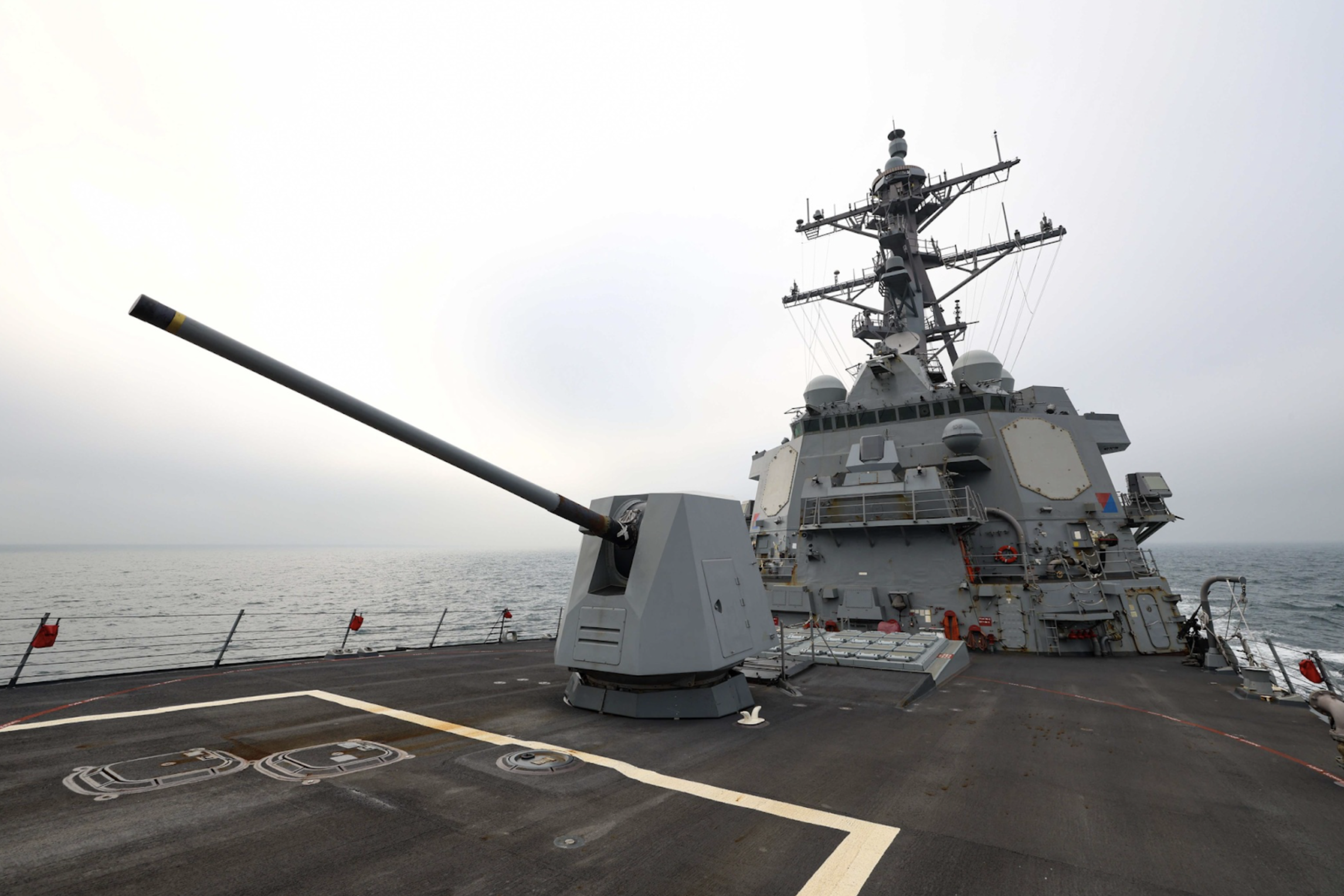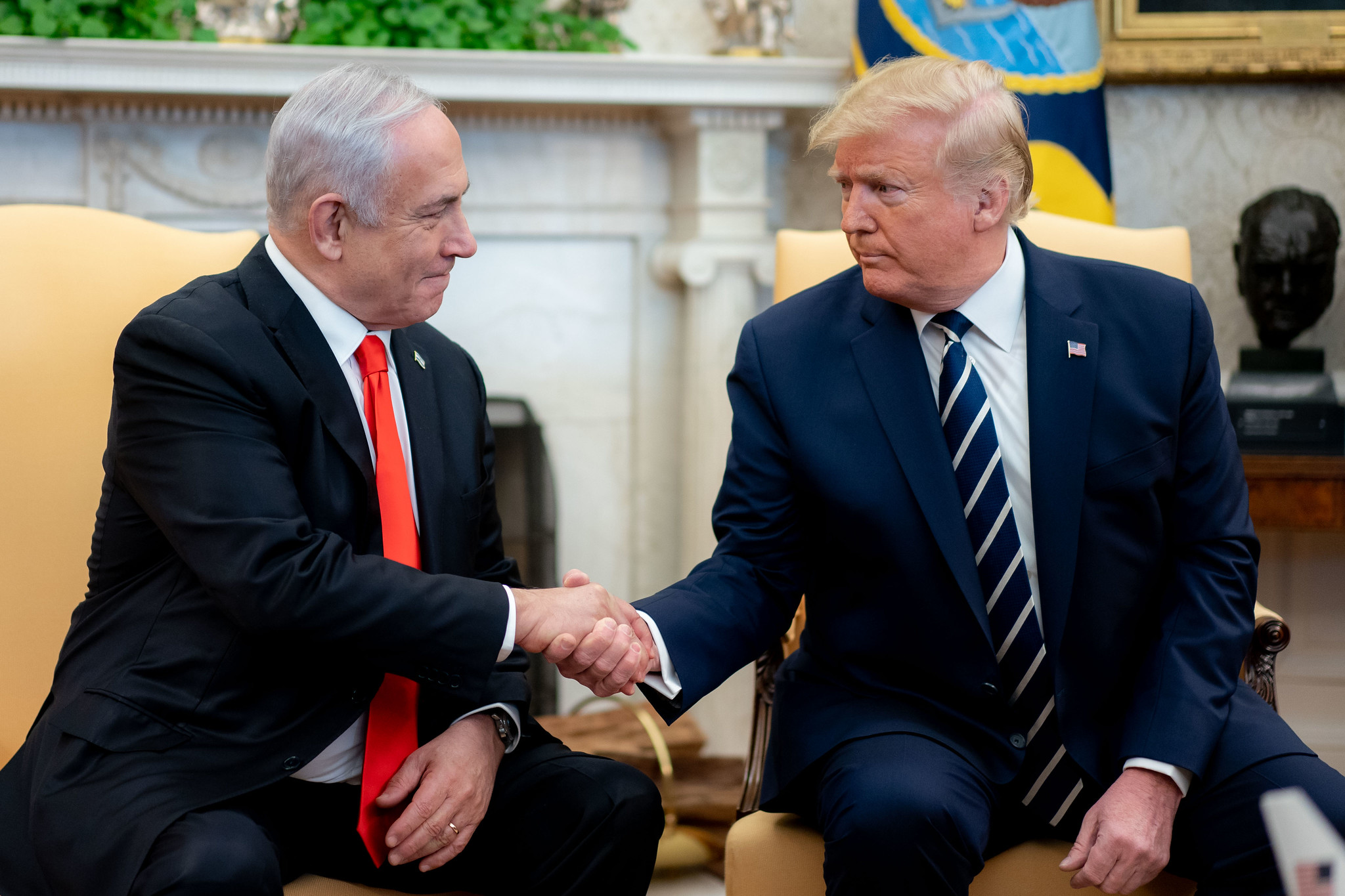Water Wars: Chinese Fishermen Drown Following Chase Near Taiwan-Controlled Island
Four injured in latest Second Thomas Shoal incident; congressional delegation visits Taiwan; funding approval for updated COFA allays anxiety over Pacific Islands; and more.

Published by The Lawfare Institute
in Cooperation With

Chinese Fishermen Drown While Fleeing Taiwan Coast Guard
On Feb. 14, two Chinese fishermen fleeing Taiwan’s coast guard drowned off the coast of Kinmen archipelago, also known as the Quemoy. The Kinmen archipelago is a group of islands just six miles from mainland China that Taiwan has governed since the end of the Chinese civil war in 1949. The incident raised cross-strait tensions, as China’s Taiwan Affairs Office called for an investigation of the “malicious event” that “severely harmed the feelings of compatriots on both sides of the Taiwan Strait.” The office’s spokeswoman, Zhu Fenglian, said that for a long time, Taiwan’s “Democratic Progressive Party authorities have been using all sorts of excuses to forcefully inspect Chinese fishing vessels, and using violent and dangerous methods towards Chinese fishermen.” Taiwan’s Mainland Affairs Council said that Beijing has long ignored its requests to halt extracting sand and catching fish in Taiwanese waters and that the coast guard was “enforcing its duties in line with the law.”
Just one month later, two crew members from a Chinese fishing boat went missing after their boat capsized southwest of Dongding Island in Kinmen County. According to Taiwan’s Coast Guard Administration (CGA), the Min Long Yu 61222 sank 555 meters inside Taiwan’s “prohibited waters.” While the other two fishermen on the boat were found dead, according to the CGA, Taiwan and China have cooperated in extensive search and rescue missions for the missing fishermen. Taiwan’s Ocean Affairs Council Minister Kuan Bi-ling said the two have been working together after China requested Taiwan’s help. In a Facebook post on March 13, Taiwanese Democratic Progressive Party Legislator Wang Ting-yu wrote that Taiwan’s policy is to “rescue those in distress, and expel or ban those who violate the law.”
United States Continues Messaging Support for Taiwan
USS John Finn Makes Its Second Taiwan Strait Transit in 2024
On March 5, the USS John Finn transited the Taiwan Strait, from the South China Sea to the East China Sea. The U.S. Navy 7th Fleet, headquartered in Japan, stated that the guided-missile destroyer’s transit was routine. U.S. ships have transited the Taiwan Strait “for many years,” according to the 7th Fleet’s statement, and the corridor through which the USS John Finn traveled is one in which “all nations enjoy high-seas freedoms of navigation, overflight, and other internationally lawful uses of the sea related to these freedoms.” The 7th Fleet also published photos of the destroyer in the strait, which is one of the busiest global shipping corridors and a focal point of geopolitical tensions in the region.
The USS John Finn previously passed through the Taiwan Strait in January from the East China Sea to the South China Sea. China accused the United States of openly hyping the January transit by publicizing it, and a People’s Liberation Army (PLA) spokesperson said that the United States “frequently carried out provocative acts and maliciously undermined regional peace and stability.” U.S. Navy warships and aircrafts transited the strait 11 times in 2023 and 10 times in 2022—all freedom of navigation operations, or FONOPs. The 7th Fleet has stated that such operations uphold “the rights, freedoms, and lawful uses of the sea” by challenging “restrictions on innocent passage.”
In response to the March 5 transit, a PLA spokesperson said that its Eastern Theater Command “organized naval and air forces to track and monitor the entire process” and that PLA troops “always maintain a high state of alert, ready to respond to all threats and provocations at any time.” According to a Taiwan Ministry of National Defense post on X, the PLA had 12 aircraft and six naval vessels in the strait during the USS John Finn’s passage. The ministry said in its post that two of the PLA aircraft crossed over the median line of the Taiwan Strait, into “Taiwan’s southwestern and eastern ADIZ [Air Defense Identification Zone].”
At a meeting between President Joe Biden and Chinese President Xi Jinping on the sidelines of the Asia-Pacific Economic Cooperation summit in San Francisco in November 2023, China and the United States agreed to resume military-to-military communications in part to prevent escalation from routine military drills and patrols in hotspots like the Taiwan Strait.
U.S. Congressional Delegation Visits Taiwan Amid Heightened Cross-Strait Tensions
A bipartisan group of U.S. lawmakers visited Taiwan at the end of February to assure the Taiwanese government of U.S. support in the face of increasing pressure from China. Rep. Mike Gallagher (R-Wis.)—chair of the bipartisan House Select Committee on the Chinese Communist Party, which has garnered attention for its hawkish hearings on U.S.-China competition—led the delegation, which included four other members of the select committee. The delegation met with senior Taiwanese leaders and members of civil society during the three-day trip to discuss U.S.-Taiwan relations, as well as regional trade and security issues. In a meeting with Taiwanese President Tsai Ing-wen, Gallagher described the U.S.-Taiwan relationship as “stronger and more rock-solid than ever now.” Gallagher said that “freedom is under attack from authoritarian aggression” and called Tsai a “leader within the free world.” Tsai, who will be replaced by Lai Ching-te in May, said that Taiwan hopes to see “even more Taiwan-U.S. exchanges” in 2024. Gallagher also told a news conference in Taipei that “the people of Taiwan should be confident that America stands with them even as we see through a very intense political season domestically.” Both Tsai and Lai, who won Taiwan’s presidential election in January, are members of the Democratic Progressive Party, which has maintained that Taiwan is separate from China. In his victory speech in January, Lai promised that Taiwan would “continue to walk side by side with democracies from around the world.”
During the February visit, Rep. Gallagher and Rep. Raja Krishnamoorthi (D-Ill.)—the select committee’s ranking member—also suggested ways to speed up U.S. delivery of military weapons to Taiwan. Taiwan’s backlogged arms orders from the United States total around $20 million. An aid package focused on Ukraine and Israel that included $1.9 billion to replenish U.S. weapons to Taiwan passed in the Senate in February but has stalled in the House.
The U.S. congressional visit, which was the second to Taiwan this year, drew an immediate response from China. Chinese Ministry of Foreign Affairs spokeswoman Mao Ning stated that “Taiwan is an inalienable part of Chinese territory” and reinforced that “China opposes any form of official interaction between U.S. and Taiwanese authorities and rejects U.S. interference in Taiwan affairs in whatever form or under whatever pretext.” For context, 32 U.S. lawmakers visited Taiwan last year.
Amid Ever-Increasing Tension With China, the Philippines Pushes Back With Domestic Legislation and Joint Patrols
The Philippines and China Trade Blame in the Latest Second Thomas Shoal Incident
As reported in previous editions of Water Wars, China and the Philippines remain in a tense standoff over the BRP Sierra Madre, a World War II-era ship built for the U.S. Navy that the Philippines intentionally grounded on the Second Thomas Shoal (Philippines: Ayungin Shoal; China: Ren’ai Jiao; Vietnam: Bãi Cỏ Mây; Taiwan: Ren’ai Ansha) in 1999. Since the ship’s grounding, the Philippines has maintained a regular garrison of military personnel to reinforce its claim of sovereignty over the shoal, which China contests, and sends routine resupply missions to the vessel. On March 5, Chinese coast guard cutters blasted water cannons and rammed the Philippines’s latest resupply mission to the BRP Sierra Madre, injuring four Filipino crew members and damaging two Philippine vessels. The incident marks the first time Philippine personnel have been injured by China’s attempts to blockade Second Thomas Shoal since last year.
Manila and Beijing traded blame for the accident. According to the Philippines, the incident was the result of “reckless and illegal” behavior on the part of the Chinese coast guard. In response, Gan Yu, a spokesman for the Chinese coast guard accused the Philippines of ignoring repeated warnings from China, violating the International Regulations for Preventing Collisions at Sea, and deliberately ramming into the coast guard vessel. U.S. State Department spokesperson Matthew Miller released a statement on the day of the incident condemning China’s actions and accusing it of disregarding both “the safety and livelihoods of Filipinos and international law.” The statement also emphasized that the 1951 U.S.-Philippines Mutual Defense Treaty (MDT) covers all “armed attacks on Philippine armed forces, public vessels, or aircraft … anywhere in the South China Sea,” in accordance with new treaty guidelines issued in May 2023. In a post on X, the Chinese Ministry of Foreign Affairs dismissed the statement from the United States as “a misrepresentation of facts” and rested responsibility for the incident near the Second Thomas Shoal “completely with the Philippines.” Philippine President Ferdinand Marcos Jr. has for now declined to invoke the aid of the United States under the 1951 MDT, believing that China’s actions in the most recent Second Thomas Shoal incident are insufficient to activate it.
Manila did, however, summon Beijing’s deputy chief of mission in the Philippines, Zhou Zhiyong, to protest the incident. President Marcos also warned that a lack of efficient bilateral communication between China and the Philippines has greatly increased the risk of armed conflict involving the two countries in the disputed South China Sea. Seeking to mitigate rising tensions in the region, Marcos urged Xi to expedite the creation of a China-Philippines hotline on the sidelines of the three-day 2024 ASEAN-Australia Special Summit in Melbourne, Australia.
Beijing Erects New Floating Barrier at Scarborough Shoal
As part of an ongoing string of maritime confrontations between the Philippines and China that were reported on in a previous Lawfare article, China’s coast guard installed a floating barrier to obstruct the entrance to Scarborough Shoal (China: Huangyan Dao; Philippines: Panatag Shoal/Bajo de Masinloc), a shoal located within the Philippines’s exclusive economic zone and frequented by Philippine fishermen, but subject to the competing territorial claims of Manila and Beijing. Days later, the Philippine Coast Guard severed and removed the barrier, which drew criticism from China’s foreign ministry. In February, however, satellite imagery revealed that a new floating barrier had been erected to block the entrance to the shoal. China’s foreign ministry confirmed that Beijing had placed the new barrier, claiming that China “has to take necessary measures” to safeguard its territorial sovereignty and maritime interests. On Feb. 22, China’s coast guard said it had driven off a Philippine vessel that “illegally intruded” in the waters surrounding Scarborough Shoal. The Philippines disputed that claim, announcing that its vessel, the BRP Datu Sanday, was in the area to “protect the rights and safety of Filipino fishermen.” The Philippines counter-accused China of illegally fishing with cyanide and maneuvering dangerously to block Philippine vessels in the vicinity of Scarborough Shoal. Philippine Coast Guard spokesperson Jay Tarriela said that the barrier was removed shortly after the Philippine ship departed from the area but claimed that Beijing erects a barrier “every time” a Philippine government vessel approaches Scarborough Shoal.
Philippine Legislature Passes Maritime Zones Act in Spite of China’s Opposition
In March, the Philippine legislature approved the Philippine Maritime Zones Act, a domestic law declaring the maritime zones and jurisdiction of the Philippines in order to “harmonize” domestic law with the United Nations Convention on the Law of the Sea (UNCLOS). The country’s Department of Foreign Affairs stated that the act will enable the Philippines to “effectively enforce” domestic and related international laws in order to protect its marine resources, conserve the environment, and “enhance maritime safety and security.” According to Philippine Ambassador to the U.S. Jose Manuel Romualdez, the Senate’s approval demonstrated that the Philippines is “serious about not giving up any [of its] territorial sovereignty.” In addition to declaring the Philippines’s maritime zones, the act, which was approved by both houses of the Philippine legislature on March 19, 2023, states that the Philippines will “exercise all other maritime rights and jurisdictions in accordance with UNCLOS [and] the 2016 South China Sea arbitral award.”
The 2016 South China Sea arbitral award largely upheld the Philippines’s territorial claims in the South China Sea against China’s competing claims. Since that ruling was issued, China has refused to abide by it, calling it “nothing more than a piece of waste paper” and continuing to assert its own maritime claims. In keeping with that history, China’s foreign ministry spoke out in opposition to the Maritime Zones Act earlier this month. Spokesperson Mao Ning alleged that the Philippine Senate was attempting “to further enforce the illegal arbitral award” through domestic legislation encompassing areas over which China asserts sovereignty, including the Spratly Islands (China: Nansha Qundao; Philippines: Kalayaan Islands; Vietnam: Quần đảo Trường Sa) and Scarborough Shoal (China: Huangyan Dao; Philippines: Panatag Shoal/Bajo de Masinloc). Mao stated that China “firmly opposes” the act and claimed that it violates international law, including UNCLOS and the UN Charter, and encouraged the Philippines to “return to the right track of properly settling differences through negotiation and consultation.” The Chinese state-run news outlet Global Times wrote that passage of the act was a provocation against China and claimed that “blindly” resolving disputes through legal resolutions “ignor[es] reality” and is inappropriate for complex South China Sea issues. Philippine spokesperson Jay Tarriela took to social media to argue that the Maritime Zones Act fully complies with UNCLOS and that its zones were “not arbitrary lines.” He accused China of willingness to “violate, abuse, and disrespect” international law in spite of its own status as an UNCLOS signatory. Philippine Senator Francis Tolentino, the Maritime Zones Act’s sponsor, called China’s opposition “futile,” since China “cannot veto” the law. Philippine House of Representatives Majority Leader Neptali Gonzales II claimed that the Philippines would not be influenced by China’s stance on the issue, stating “this is what we need, and we are going to do it for our country and not for China.” Philippine Defense Secretary Gilberto Teodoro Jr. referred to China’s statements of opposition as “propaganda mechanisms” and claimed that “no right thinking state” believes China’s claims. A Philippine security official argued that China’s aggressive actions toward the Philippines in the South China Sea “negate” Beijing’s calls for dialogue; in the lead-up to the act’s passage, Sen. Tolentino suggested that China was engaging in aggressive maritime activities in waters near the Philippines in order to express Beijing’s dissatisfaction with the legislation.
U.S.-Philippines Hold Joint Air Patrol, Drawing Criticism From China
Three Philippine FA-50 fighter jets flew together with a U.S. Pacific Air Force B-52H Stratofortress bomber plane over the South China Sea on Feb. 19, a week after the two countries’ navies held joint maritime exercises in the face of growing tensions over territorial claims in the area. The joint patrol covered an area of 90 nautical miles west of Candon, Ilocos Sur province, and 50 nautical miles northwest of Lubang, Mindoro province.
Philippine Air Force (PAF) spokesperson Col. Maria Consuelo Castillo clarified in a message to reporters that the Philippines’s joint air patrols with the United States over portions of the South China Sea were not directed at any country but instead aimed at improving interoperability between the two allies. The PAF posted photos and videos of the patrol on Facebook, along with a message describing the patrol as a “cooperative activity aim[ed] to bolster cooperation between the Armed Forces of the Philippines and their US counterparts.” The post also emphasized that, through the patrol, the PAH was “underscor[ing] its commitment and readiness to support the [Armed Forces of the Philippines’s] efforts in safeguarding the national territory and sovereign rights, and upholding regional peace and security.” PAF Public Affairs Chief Xerxes Trinidad also commented, noting the patrol was to enhance interoperability and enhance the PAF’s capacity to protect “Philippine territory, sovereignty rights and national interests.” He also noted that the Philippines expects to carry out future joint maritime activities with the United States and other like-minded partners.
In a statement on Weibo, the Chinese military’s Southern Theater Command described the joint air patrol as a publicity stunt. China also accused the Philippines of upsetting order in the South China Sea by enlisting countries outside the region. Shortly after the patrol, China announced that it had sent naval and air forces to closely watch the situation to keep it “under control” and “maintain a high level of vigilance” to defend Chinese national sovereignty and preserve regional stability.
Philippine National Security Adviser Eduardo Año rejected China’s narrative that the Philippines was “stirring up trouble” in the disputed South China Sea by holding the Feb. 19 joint air patrol with the United States. Año countered that the patrol was held entirely within Philippine territorial waters, as recognized under UNCLOS, and urged China to respect the Philippines’s sovereign rights. He also reiterated that the Philippines is committed to a rules-based order in the region and to cooperating with partners to ensure regional security and prosperity.
The United States and China Continue to Compete for Influence in the Pacific Islands
Congress Approves Updated Agreements With the Freely Associated States, Allaying Anxiety
After months of delay that raised alarm bells in the Pacific Islands, Congress approved and funded the updated Compacts of Free Association (COFA) as part of the omnibus budget package in early March. The COFA governs the “free association” relationships between the United States and Micronesia, the Marshall Islands, and Palau. While affirming the self-determination of those Freely Associated States (FAS), the COFA primarily exchanges their authority over “security and defense matters[,]” which is granted to the United States indefinitely, for economic support, which must be reauthorized every 20 years, and U.S. defense guarantees.
The U.S. and the FAS signed updated 20-year agreements totalling $7.1 billion last year after the 2003 agreements lapsed, but Congress repeatedly kicked funding for those agreements from one legislative vehicle to the next despite bipartisan support spearheaded in part by Reps. Ed Case (D-Hawaii) and Steve Womack (R-Ark.). The COFA ended up on the chopping block of various packages reportedly because Speaker of the House Mike Johnson (R-La.) had doubled-down on insisting that the COFA be offset by cuts or revenue generation elsewhere.
That lapse in funding and perceived congressional deprioritization of the COFA led FAS officials and Indo-Pacific analysts to express concern about the U.S. commitment to reliable economic support for the region and ceding ground to China. COFA transfers represented about 30 percent of FAS gross domestic product from 1987 to 2024 and had been declining steadily in the run-up to the 2023 expiration. The presidents of the FAS sent a joint letter to Senate leadership in February warning that the delay in funding approval “generated uncertainty among [their] peoples” that “has resulted in undesirable opportunities for economic exploitation by competitive political actors active in the Pacific.” Leaked private letters from the Marshall Islands and Palau presidents to unnamed senators were even more explicit about offers by China waiting in the wings for U.S. influence to wane.
As mentioned in previous Lawfare columns, the Marshall Islands and Palau are among the 12 remaining states that recognize Taiwan. Only one other state in East Asia and the Pacific—Tuvalu—recognizes Taiwan after Nauru revoked its recognition in January, and Palau’s president commented in February that they and the Marshall Islands are “under pressure to re-evaluate [their] relationship” with Taiwan. Congressional approval quieted these alarm bells, but maritime conflict analysts still fear that this saga has had a long-term impact on FAS trust in the United States.
United States Voices Concern After Kiribati Accepts Chinese Police Presence
Kiribati officials told Reuters that uniformed Chinese police have been working with local law enforcement on community policing and a crime database, which a U.S. State Department spokesperson warned may have “implications” for the island nation’s “autonomy.” Kiribati’s closest island is only 1,305 miles from Hawaii. Sen. Brian Schatz (D-Hawaii) argued in a statement that the news “underscore[s] the need” to continue strengthening U.S. regional partnerships, including through the COFA.
The move follows a string of Chinese efforts to create security partnerships with Pacific Island nations. China provided grant funding for a feasibility study regarding upgrading a U.S.-built World War II-era airstrip in Kiribati, though Kiribati’s government has insisted that the airstrip would be for purely civilian use. One former Kiribati president speculated after Kiribati pulled out of the Pacific Islands Forum that the island nation may also be weighing a more comprehensive security agreement with China, which U.S. Institute of Peace analysts say could be similar to the security cooperation agreement between China and the Solomon Islands that sparked concern in 2022.
Meanwhile, Japan’s Ministry of Defense hosted the 2nd Japan Pacific Islands Defense Dialogue in Tokyo this month, which featured representatives from 13 Pacific Island nations. The meeting helped prepare for the 10th Pacific Islands Leaders Meeting—which Japan has hosted every three years—scheduled for July.
Analysis
Zhihua Zheng, head of the East Asia Marine Policy Project at Shanghai Jiao Tong University, writes that because of the disparity in naval power between the Philippines and China, the former has adopted a new “playbook” in the South China Sea, using its fishermen in gray zone operations and employing an “assertive transparency” strategy to gain international attention. He argues that because Manila lacks the naval power to eject Beijing from areas like Scarborough Shoal and Second Thomas Shoal, it uses its fishermen as pretext to maintain a constant presence in the surrounding waters. According to Zheng, although the 2016 South China Sea Arbitration confirmed that the Philippines possesses traditional fishing rights in the vicinity of Scarborough Shoal, the ruling did not address the Philippine government’s authority to patrol and enforce laws in the shoal. The issue of territorial sovereignty, he claims, is outside the scope of an arbitral tribunal governed by UNCLOS. However, by engaging in the described gray zone tactics, the Philippines is able to “skillfully shift[] the blame” for its provocations onto Beijing and portray itself as the victim. He argues that although China has so far been able to separate maritime incidents from regular bilateral exchanges, goodwill between the parties is “diminishing” and that may seriously impact the region’s peace and stability.
At Time, Chad de Guzman and Koh Ewe write that Beijing’s response to the deaths of two Chinese fishermen in February during an incident in which the fishing vessel crossed a maritime boundary and were chased by Taiwan’s coast guard has been “uncharacteristically restrained.” The authors argue that the incident could have been used to further increase existing tensions over Taiwan’s sovereignty. Although the Chinese public expressed “outrage” at the “blatant provocation,” Beijing’s official condemnation has been “relatively muted.” Citing Chin-Hao Huang, an associate professor of political science at the National University of Singapore, the authors write that China’s modest reaction to the incident could be attributable to “tacit recognition” that the fishermen’s actions were illegal, or to the possibility that deaths of fishermen might not rank very highly on China’s hierarchy of priorities (unlike, for example, if Taiwan was to shoot down a drone or aircraft).
John Bradford writes for Asia Maritime Transparency Initiative (AMTI) that the Indo-Pacific region suffers from a multitude of maritime security challenges including interstate tensions, natural disasters, and criminal activity, which resulted in a total of 1,882 individuals missing or dead in regional waters in the first half of 2023. Bradford attributes this to insufficient maritime governance resulting from the operation of international law, which places the burden of governance on states. Many states in the region do not have the capacity to provide adequate governance, which “effectively guarantees” that unscrupulous commercial entities, criminals, militants, and even states themselves will exploit the gaps to gain an advantage. Efforts by “higher-capacity” states to build better governance both lack coordination and are “poorly aligned with recipient states’ needs.” He argues that to address this problem, the United States should initiate the development of a “maritime governance center of excellence” (COE). Bradford envisions that this new COE would consolidate best practices, conduct research and analysis, provide training to regional officials, deconflict capacity-building efforts, host educational forums, and facilitate interactions between regional stakeholders. He argues that the COE would function best if it were led by a group of like-minded states and suggests that the Quadrilateral Security Dialogue or a similar partnership could fill that role. He also suggests choosing a lower-capacity partner to host the COE to lower the costs of implementation and give partner states a more influential voice. Bradford specifically rules out China as a participant in the COE, despite its strong navy and merchant marine fleets, because of its habitual disregard of international law and attempts to undercut maritime governance efforts.
AMTI published a feature in February on China’s maritime militia, which has come under international observation in the past year over its close integration with the Chinese coast guard and its involvement in China’s conflict with the Philippines over Second Thomas Shoal. AMTI examined satellite imagery of nine South China Sea features and constructed graphs showing maritime militia activity by location during 2023. According to AMTI’s analysis, the graphs show that maritime militia activity increased 35 percent overall in 2023, compared to AMTI’s last analysis conducted over a 12-month period spanning 2021 and 2022. The data also revealed one unusually large spike in activity around Mischief Reef (China: Meiji Jiao; Philippines: Panganiban Reef; Taiwan: Meiji Reef; Vietnam: Đá Vành Khăn) during summer 2023. AMTI reported that 180 militia vessels were observed near Mischief Reef, compared with a normal peak of about 37 vessels. AMTI was unable to determine the reason for this surge in activity.
At the Heritage Foundation, Wilson Beaver writes that although the Indo-Pacific is a maritime theater and the U.S. Navy and Air Force would have the largest role to play in a regional conflict, there is still room in the Indo-Pacific for the U.S. Army. According to Beaver, the Army would have two roles: One would be to provide logistics and air support for advanced air fields, a role the Army has filled in the past, and the other would be a fairly new role for the Army—providing shore-based anti-access capabilities. He argues that because of funding challenges, the Army may have to downsize to fund the platforms that would be needed to fill this role. Beaver notes that the U.S. Marine Corps has already done something very similar in “Force Design 2030,” overhauling itself into a lighter and more agile force with the Indo-Pacific in mind. He argues that while it is not a “perfect fit” for the Army, which would need to maintain heavier assets like tanks, the Army can still derive useful lessons from Force Design 2030 regarding how to be relevant in the Indo-Pacific theater. Beaver argues that the Army should also take note of recent “outsized success” of the Ukranians and Houthis in land-based targeting of ships. Lastly, Beaver advises that the Army should expand joint training exercises in the Indo-Pacific to new partners in order to build up regional capabilities and deter China from launching an attack.
At the Center for Strategic and International Studies (CSIS), Jude Blanchette, Ryan Hass, and Lily McElwee summarize the key insights gleaned from an international task force convened by CSIS to develop a strategic narrative concerning Taiwan. According to their paper, deterring China from destabilizing the Taiwan Strait will require a strong international coalition of partners, and to attract such a coalition, the U.S. needs a “compelling narrative for why Taiwan matters that instills urgency” across a wide range of nations and achieves their buy-in. According to Blanchette, Hass, and McElwee, a broader coalition of stakeholders would send an “unmistakable” message to Beijing that a decision to escalate the Taiwan Strait conflict would carry a significant cost. Emphasizing the global economic and military impact of instability in the Taiwan Strait, the paper calls for unity building to ward off such outcomes. The paper summarizes the task force’s findings into six key takeaways: (a) Much of the world sees the U.S. involvement with Taiwan as a primary contributor to escalating tensions; (b) “crisis fatigue” resulting from repeated warnings by the U.S. about timelines for an invasion and multiple overlapping global events makes leaders less likely to push for more engagement on Taiwan; (c) emphasis on democratic values is less likely to motivate countries to support Taiwan than a pragmatic focus on specific interests and tangible benefits; (d) Taiwan must be “de-hyphenated” from China and promoted as critical to stability and prosperity in its own right; (e) global leaders and citizenry need better education regarding Taiwan and the history of cross-strait conflict; and (f) as the most capable “counterweight” to Beijing, the U.S. must not waver in its messaging of support for Taiwan.








